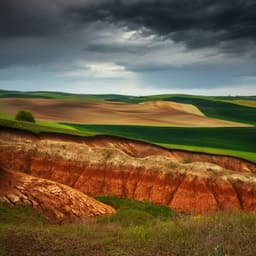
Earth Sciences
Ocean and land forcing of the record-breaking Dust Bowl heatwaves across central United States
T. Cowan, G. C. Hegerl, et al.
Explore the riveting insights of Tim Cowan and colleagues as they unveil how the 1930s Dust Bowl's drought and extreme heatwaves were intensified by both natural phenomena and human activities. This research reveals critical connections between atmospheric conditions and vegetation feedbacks, signaling potential challenges in a warming world.
~3 min • Beginner • English
Introduction
The study addresses why the 1930s Dust Bowl heatwaves over the central United States were so extreme and to what extent they were driven by oceanic forcing versus land-surface changes. Many daily temperature records from the 1930s still stand and are not due to instrumental bias. Previous work suggests strong atmospheric ridging and land–atmosphere interactions contributed, with the decade featuring cool North Pacific and warm North Atlantic SSTs. However, AGCMs forced with observed SSTs underestimate the drought’s extent and severity unless historical land-cover changes and dust aerosols are included. With increasing future heatwave risk, the purpose here is to quantify the roles of Atlantic and Pacific SST anomalies in preconditioning and triggering heatwaves, and to test how rapid devegetation and exposed soils in the 1930s amplified heatwave activity over the central US (105°–85°W, 30°–50°N).
Literature Review
Prior studies highlight that AGCMs forced with observed SSTs alone often fail to reproduce the Dust Bowl drought’s magnitude and extent, but performance improves when historical land-cover change and dust aerosol forcing are included (e.g., Cook et al., Hu et al.). Observed extreme heat has been linked to persistent mid-tropospheric ridges and strong land–atmosphere coupling. Decadal SST variability, including the AMO and PDO, has been associated with US drought and heat extremes. Some AGCM and coupled model studies emphasize Pacific SST influences on Great Plains droughts, whereas others underscore Atlantic multidecadal variability’s role in North American summer climate and heat waves. Models often exhibit warm biases and overly strong land–atmosphere coupling over central and southern North America, leading to excessive drying and difficulty reproducing the exceptional nature of the 1930s extremes. The extent of 1930s devegetation is uncertain, but estimates of bare soil range from 20–80%, with dust aerosols potentially suppressing precipitation via radiative and microphysical effects.
Methodology
- Heatwave definition and metrics: Heatwaves occur when daily Tmax and Tmin exceed their respective daily 90th percentile thresholds for at least 3 consecutive days and 2 consecutive nights. Thresholds are computed over the climatological period using a centered 15-day window. Metrics include activity (HWF: heatwave frequency; HWD: duration) and intensity (HWM: average temperature of heatwaves). The focus is on HWF to partially mitigate model warm biases. Evaporative fraction (EF = Ql/(Ql+Qh)) serves as a proxy for surface moisture.
- Observations and reanalysis: Daily temperature from GHCN-D; maximum daily Tmax anomalies from HadEX2; BEST daily data used to identify hottest heatwave dates; circulation fields (MSLP and Z500) from NOAA 20CR v2; precipitation from GHCN-D and GPCC.
- CMIP5 coupled models: piControl experiments from 22 CMIP5 models (~500 years each; total ~10,900 years) analyzed for HWF and monthly SSTs. One decade per century per model with record-breaking HWF clustered in time is identified to assess decadal clustering and associated SST states (AMO, PDO). A subset of 20 CMIP5 historical runs used to compare 1930s extremes to the model spread.
- AMO/PDO indices: Calculated annually for the same piControl periods using NCAR’s CVDP definitions (PDO as leading PC of North Pacific SST anomalies, AMO as North Atlantic area-mean SST anomaly with global mean removed).
- AGCM experiments (HadGEM3-GA6): N96 (~135–210 km) resolution atmospheric-only model (Unified Model GA6.0; land: JULES 6.0) driven by daily SSTs (from monthly HadISST2.1).
• HIST: Ten-member ensemble (1916–1955) with different SST realizations capturing observational uncertainties plus standard CMIP5 historical forcings.
• ATL_HIST (ATLHIST): Five-member ensemble with historical Atlantic SST anomalies; other basins cycle through a 1916–1955 climatology (SST/ice poleward of 60°N and below 50°S kept at climatology).
• PAC_HIST (PACHIST): Five-member ensemble with historical Pacific SST anomalies; remaining oceans at climatology. Residual response evaluated as ATLHIST − PACHIST.
Heatwave metrics computed relative to the HIST ensemble climatology (1916–1955). Dust Bowl period defined as 1930–1937.
- Circulation composites: For each dataset/experiment, identify the hottest summer heatwave week per year over the central US via heatwave start dates and spatial concurrence; composite MSLP and Z500 over 7 days across 1930–1937 to assess circulation patterns associated with extremes.
- Bare-soil sensitivity experiments: Convert C3/C4 grass to bare soil over the central US such that average bare soil in 1930 increases from ~15.3% (HIST) to ~30%, 50%, and 80%. Bare soil fractions linearly interpolated between decadal ancillaries; return to 15.3% by 1940. Dust aerosol load increases accordingly in spring. Single realization per bare-soil level; significance inferred where values lie outside the 10-member HIST range.
- Significance testing: Mann–Whitney U tests for ATLHIST vs PACHIST HWF differences (1930–1937); bootstrap methods (10,000 resamples) for precipitation and EF differences; bootstrapping in CMIP5 piControl to assess decadal clustering likelihood.
Key Findings
- The 1930s were the most active summer heatwave decade over the central US, with some locations averaging ~22 heatwave days per summer and longest events exceeding 10 days in 1934 and 1936. Maximum daily Tmax anomalies exceeded 6 °C; these exceed the spread of CMIP5 historical simulations for the 1930s.
- CMIP5 piControl (∼10,900 years) indicates central US heatwaves are more frequent during a warm AMO and cool PDO. A rare piControl decade (GFDL-ESM2G years 286–296) exhibits Dust Bowl-like, spatially extensive heatwaves with warm North Atlantic and cool eastern Pacific SSTs, showing such events can occur without external forcings.
- HadGEM3 AGCM ensembles: ATLHIST produces significantly stronger and more extensive heatwave activity and intensity across the southern–central US than PACHIST (95% Mann–Whitney). HIST underestimates observed activity and shows warm and precipitation biases typical of AGCMs.
- Circulation: Observed hottest weeks featured a western US surface high and an eastern US mid-tropospheric ridge. ATLHIST reproduces a strong heat low and upper-level ridge over eastern US; PACHIST shows a weaker, displaced response. However, summer circulation differences alone (ATLHIST−PACHIST) are not statistically distinct, implying other processes contribute to heatwave differences.
- Spring preconditioning: ATLHIST exhibits significant April–May precipitation deficits and lower evaporative fractions over the southern–central US relative to PACHIST, associated with weaker meridional moisture flux from the Gulf of Mexico and higher Z500 in spring (by ~5–15 m), leading to drier soils, higher Tmax, and enhanced summer heatwave activity.
- Land-cover changes: Bare-soil experiments show strong sensitivity of heatwaves to devegetation. Average HWF over southern–central US increases from ~6 days (30% bare soil) to ~17 days (50%) and ~33 days (80%) per summer (1930–1937). Increases are driven by earlier evaporation deficits, soil desiccation, reduced latent heat flux, and a thicker boundary layer; precipitation differences between 50% and 80% cases are minor.
- Land-surface processes dominate heatwave amplification in bare-soil experiments; little change is found in large-scale moisture fluxes. No clear land albedo signal is detected despite higher dust loading; potential aerosol indirect effects on precipitation are not represented.
Discussion
The results indicate North Atlantic SST anomalies were a key external driver of Dust Bowl-era heatwaves by inducing springtime ridging, weakening Gulf moisture transport, and preconditioning soils for summer extremes. Pacific SSTs played a comparatively smaller role in heatwave development in HadGEM3, though they have been implicated in Great Plains drought in other models. Despite realistic SST forcing, AGCMs fail to reproduce the exceptional magnitude of the 1930s heatwaves, likely due to insufficient representation of rapid, widespread land-cover changes and dust. Sensitivity experiments demonstrate that devegetation and exposed soils can substantially amplify heatwave frequency and intensity via enhanced sensible heating and rapid soil drying. These findings highlight that vegetation and soil moisture feedbacks can strongly amplify extremes triggered by decadal ocean variability. In a warming climate, such feedbacks may lead to even more intense and frequent heatwaves and droughts over the central US, with substantial agricultural impacts even amid modern crop intensification.
Conclusion
This study disentangles oceanic and land-surface contributions to the Dust Bowl heatwaves. Using long CMIP5 control runs and targeted AGCM ensembles, it shows that warm North Atlantic SSTs favored spring drying and preconditioned the land surface, enhancing central US summer heatwaves. Idealized bare-soil experiments reveal strong amplification of heatwave activity with increasing devegetation, underscoring the role of land-surface feedbacks in producing exceptional heat. The work suggests that accurate modeling of land-cover change, soil moisture processes, and aerosol–cloud interactions is essential to capture extreme heatwaves. Future research should refine historical land-cover and dust representations, include aerosol indirect effects and irrigation, and reduce land–atmosphere coupling biases to improve attribution and projections of compound drought–heatwave events in a warming world.
Limitations
- Model biases: HadGEM3 exhibits a warm bias in summer hot extremes and wet spring bias over North America, likely due to overly strong land–atmosphere coupling, which can artificially accelerate drying and heatwave development.
- AGCM limitations: SST-forced AGCMs alone cannot reproduce the full magnitude and spatial extent of Dust Bowl extremes; responses vary across models and depend on circulation sensitivity to SSTs.
- Land experiments: Bare-soil sensitivity experiments are rudimentary, single realizations without ensembles; statistical significance is inferred relative to HIST spread. The magnitude and distribution of 1930s devegetation are uncertain; amounts used are idealized and subjective.
- Aerosol processes: Indirect aerosol effects on cloud microphysics are not included; potential impacts of dust on precipitation efficiency are therefore not captured. Land albedo changes were not evident in these experiments.
- Heatwave definition excludes humidity due to limited reliable observations in the 1930s, so heat stress aspects are not assessed.
- Missing forcings/processes in broader modeling context include irrigation and detailed crop-specific rooting-depth effects, which may influence regional temperature and moisture feedbacks.
Related Publications
Explore these studies to deepen your understanding of the subject.







